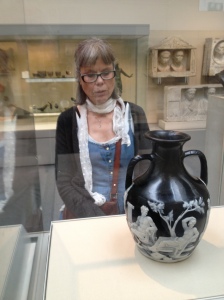John Keats and Hampstead
If you visit London and get tired of busy traffic and many tourists in the famous centre I would recommend a trip to the old village Hamstead north of London. Bus number 24 from Victoria takes you there in an hours time passing the popular Camden town.
The big Hampstead Heath separates Hampstead from Highgate. Poets and artists have flocked there. Kenwood House is in the park close to Highgate and has free admission to wonderful paintings by i.g. Turner,Vermeer, Rembrandt, Reynolds, Constable and others.
You can easily lose your way in the huge Hampstead Heath, but on a clear day you can view London from there. In the village you find Keats house, where he lived for two productive years 1818-1920. His famous “Ode to a Nightingale” was made here. He was engaged to Fanny Brawne not realising that he was already marked by tuberculosis. Fanny’s family lived in the bigger house connected to the one he lived in.
He had been intellectual stimulated in his school Enfield School very influenced by the American and French Revolution. It was said about him that he had “exhausted the school library”.
His father was killed in a horse accident when John was 6 or 7 years old. When his mother died of tuberculosis he was about 14 years old and started studying surgery. He gave up the medical training after seven years to concentrate on his poetry.
Very few recovered from treatments at that time and it shown in his poetry. His brother Tom died in 1818 and John had nursed him.
The death of his brother and the horrors he saw at Guy’s Hospital is reflected in his poems. Here from Ode to a Nightingale:
Fade away, dissolve, and quite forget
What thou among the leaves hast never known,
The wearines, the fever, and the fret
Here, where men sit and hear each other groan;
Where palsy shakes a few, sad, last gray heirs,
Where youth grows pale, and spectre-thin, and dies;
Where but to think is to be full of sorrow
And leaden-eyed despairs,
Where beauty cannot keep her lustrous eyes,
Or new Love pine at them beyond to-morrow.
Two years after Toms death John Keats also dies of tuberculosis twenty-five years old. He was nursed by Joseph Severn and stayed in Shelley’s house by the Spanish Steps in Rome. He had searched for a better climate to recover.
The poets of his time were starting the Romantic period as a reaction on the Enlightenment period.
This last summer I visited the house on the Spanish Steps in Rome where he spent his last days. Very quiet inside and a contrast to the visit in the Vatican a few hours before with crowds of tourists waiting to see the Sixtieth Chapel.
I looked out at the same view at the steps as he did. I was inspired by the visits to his two houses and a book called John Keats/ every man´s poetry selected and edited by Nicholas Roe and I remembered my time at college where I read some of his poetry with interest and great difficulty: Ode to a Grecian Urn. I am sure Keats went to see the famous ancient vase and Wedgwood’s fine replica made nearly a hundred years before.
This ambitious vase is a copy of a celebrated Roman work, which was made of cameo glass in the first century A.D. In 1783, Margaret Bentinck, second duchess of Portland, bought the Roman piece from the Barberini family; it has since been known as the Portland Vase. The sensation that the acquisition caused probably prompted Wedgwood to create his jasper copy around 1789. The first edition sold to a small group of subscribers, but the Wedgwood factory at Etruria in Staffordshire produced the vases for decades, and buyers continued to appreciate Wedgwood’s art as well as the classical pedigree of the vase itself.
Categories: Art, Favorites, Historical issues











Flot beskrivelse
LikeLike
The view from Keats’ room is beautiful! Perfect for a normal poet, but it’s a miracle that such a man submerged in tragedies still found a resort in poetry. Great man, John Keats!
LikeLiked by 1 person
Thats why I chose to write about him. Just imagine that his family just died in front of his eyes and he was only 25 years when he died himself.
LikeLiked by 1 person
Exactly! Losing one’s father, then their mother, and then nursing one’s brother, then falling ill… everyone reveres him as a poet, but no one ever tells us how much they’ve suffered, how their personal life had been like.
Hats off to his bravery!
LikeLiked by 1 person